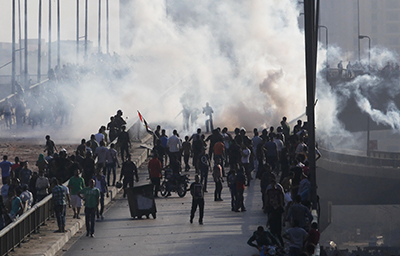New York, August 14, 2013–At least two journalists on assignment were among the hundreds killed today in clashes between Egyptian security forces and supporters of ousted President Mohamed Morsi, according to news reports. Multiple journalists have also reported being attacked, threatened, or detained.
“The Egyptian authorities must rein in the security forces and send a clear signal that journalists are not to be harmed or harassed as they try to cover the unrest,” said CPJ Deputy Director Robert Mahoney. “The tragic deaths and injuries among the press corps today are not acceptable under a government that said it took power to restore democratic freedoms.”
Security forces stormed pro-Morsi sit-ins at Rabaa Al-Adawiya in Cairo and Nahda Square in Giza early in the morning using tear gas and live ammunition, according to news reports. The raids sparked violent clashes between police and supporters of Morsi across the country. At least 235 civilians were reported killed and more than 1,000 injured, according to the Egyptian Health Ministry. Hours later, the Egyptian government announced a state of emergency as Vice President Mohamed ElBaradei resigned his position.
A cameraman for Sky News was shot dead while covering the raid outside Rabaa Al-Adawiya mosque in Nasr City, according to news reports. Mick Deane had worked for the network for 15 years, Sky News said. Sky News did not specify the origin of the fire, but said the rest of the team was unharmed.
“The Egyptian government must allow all journalists to work freely. They should also conduct an immediate investigation into who killed Mick Deane and hold those responsible to account,” CPJ’s Mahoney said.
Another Egyptian journalist was shot and killed today in Rabaa Al-Adawiya. Habiba Ahmed Abd Elaziz was a staff reporter for the local Dubai newspaper XPRESS, which is affiliated with Gulf News. Abdul Hamid Ahmad, editor-in-chief of Gulf News, told CPJ that Abd Elaziz was not on assignment for either paper and had returned to Egypt on annual leave, he said. But the journalist’s father said Abd Elaziz was covering the dispersal for Al-Jazeera when she was killed. In August 2015, Mahmoud Ahmed, a staff member of Al-Jazeera Mubasher, confirmed to CPJ that Al-Jazeera had asked Abd Elaziz to cover the sit-in.
Several journalists reported being injured. Reuters photographer Asmaa Waguih was shot in the foot while covering Rabaa Al-Adawiya, according to Reuters. She is receiving treatment in a hospital. Mohammed Alzeky, a photographer for Al-Jazeera, was shot in the arm while covering clashes, a news producer for the broadcaster, Hassan Saeed Elmogummer Taha, told CPJ.
A photographer for Al-Masry Al-Youm, Ahmed al-Najjar, was shot in the arm while covering clashes between police and supporters of Morsi, according to Hossam Fadl, a photographer for Al-Masry Al-Youm who spoke to CPJ, and news reports. Al-Najjar was shot outside Nahda Square.
Security forces detained several journalists in an attempt to restrict coverage of the raid on the pro-Morsi sit-ins. A French freelance journalist who uses the professional pseudonym “Mani” told CPJ that he was covering the unrest near Rabaa Al-Adawiya for the U.K.’s Channel 4 when he was detained and taken to Cairo Stadium in Nasr City. He said police kicked him and beat him with sticks and a gun and stole his equipment, which included his wallet, press card, and phone. Mani said he repeatedly identified himself as a journalist. His equipment has not been returned.
Mani told CPJ that he was in custody with two other journalists, Mike Giglio, an American journalist working for The Daily Beast, and Louis Jammes, a French freelance reporter. The three journalists were released after three hours, but without their equipment. In an article for The Daily Beast, Giglio said police surrounded him outside Rabaa Al-Adawiya and demanded that he give them his laptop password. He refused but was beaten repeatedly until he complied. He said Jammes was also beaten by security forces.
Giglio said in his report that an Egyptian freelance photographer, Mahmoud Abou Zeid, had also been detained at the stadium. He was not released with the other journalists. Another journalist, Abdullah al-Shami, an Al-Jazeera correspondent, was also arrested by police in Rabaa Al-Adawiya, according to Al-Jazeera. It is not clear if the journalists are still being detained.
Al-Jazeera journalists Almowhed Ballah Abdelrahman and Imad Eddin el-Saaid were also temporarily detained today, Al-Jazeera Mubashir producer Hayat el-Yamani told CPJ.
The Washington Post reported that journalist Tom Finn had been detained briefly by Egyptian security forces. Finn, who was covering Rabaa Al-Adawiya at the time, posted news of his arrest and release on Twitter.
Several journalists covering today’s events have reported being threatened by Egyptian security forces and obstructed from reporting. Journalists said that soldiers and police broke cameras, seized memory cards, and forced photographers to delete their photos. Abigail Hauslohner, Cairo bureau chief of The Washington Post, posted on Twitter that a police officer had told her, “If I see you again, I will shoot you in the leg.”
Mani told CPJ that he and a Turkish cameraman were surrounded and harassed by opponents of Morsi on Tuesday outside a government building in Cairo. He said police allowed them to seek refuge inside the building. Police told him that the crowd believed he was affiliated with Al-Jazeera or CNN, two channels that anti-Morsi protesters consider biased toward the Muslim Brotherhood.
CPJ released a special report today called “On the Divide: Press Freedom at Risk in Egypt.” The report chronicles how both the Morsi administration and the current government have disappointed the high hopes for press freedom in the aftermath of the 2011 revolution that ousted Hosni Mubarak.
- For more data and analysis, visit CPJ’s Egypt page.
EDITOR’S NOTE: This alert has been updated to reflect that two journalists, including Habiba Ahmed Abd Elaziz, were killed while covering the dispersal on assignment.
